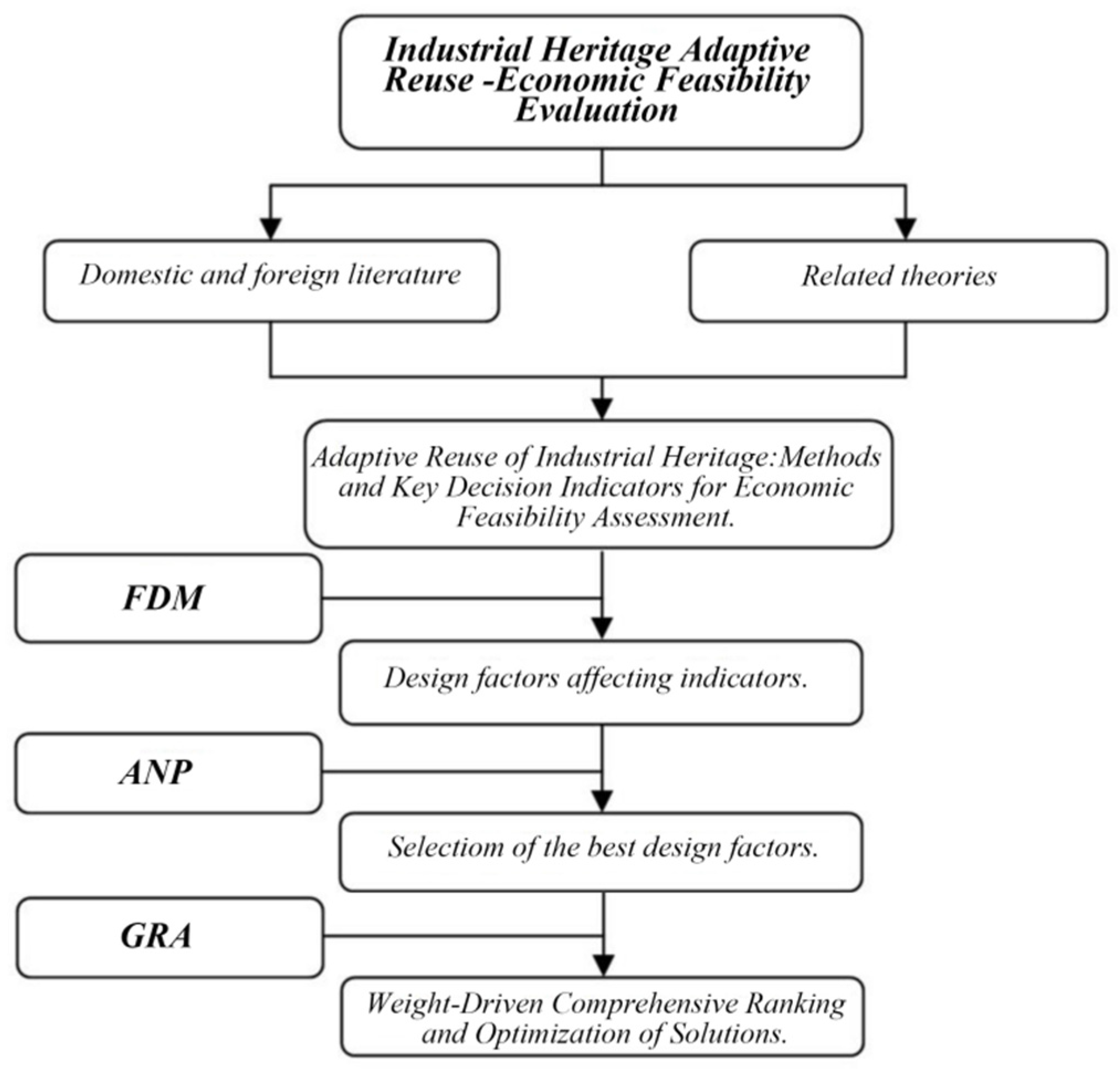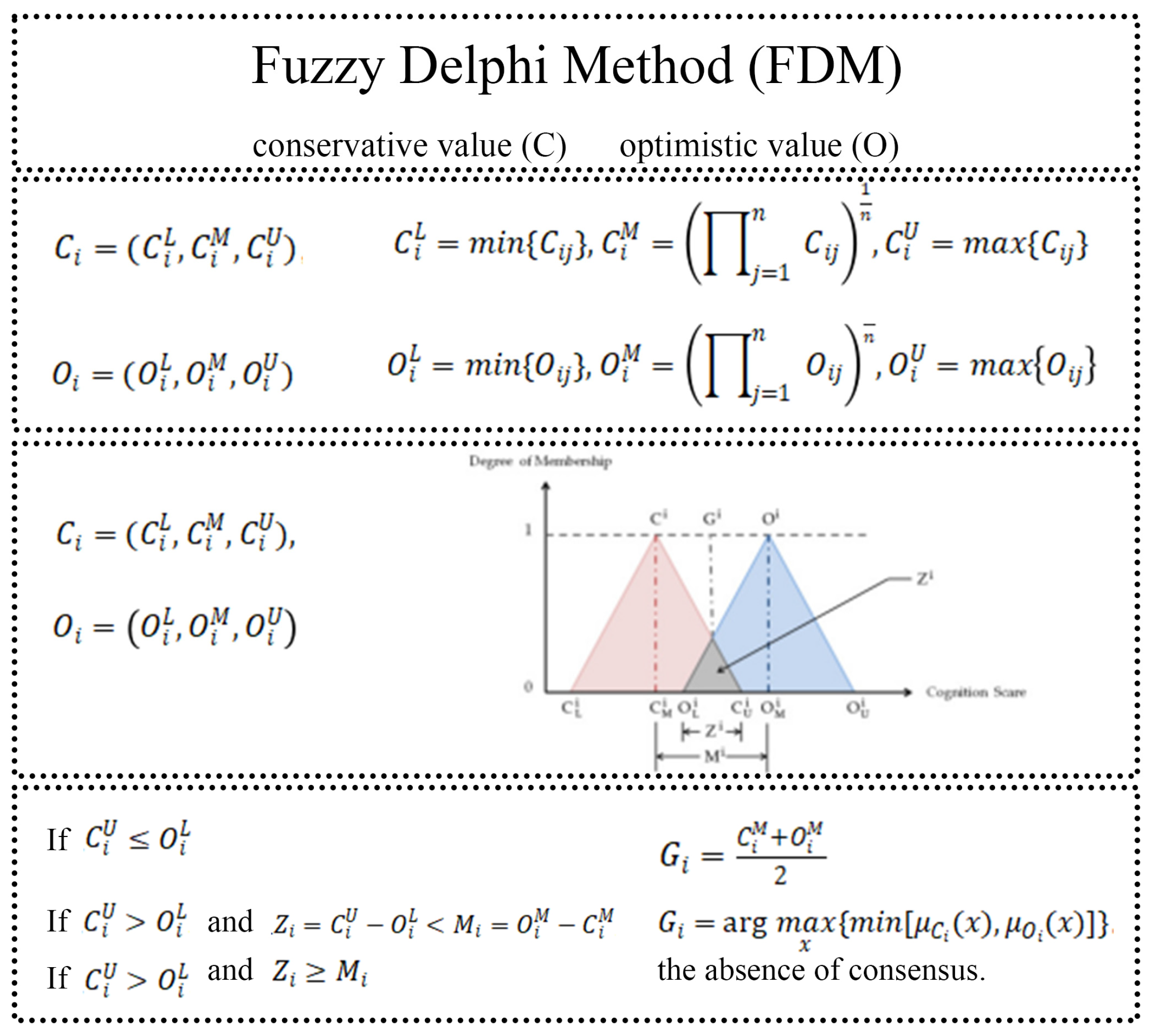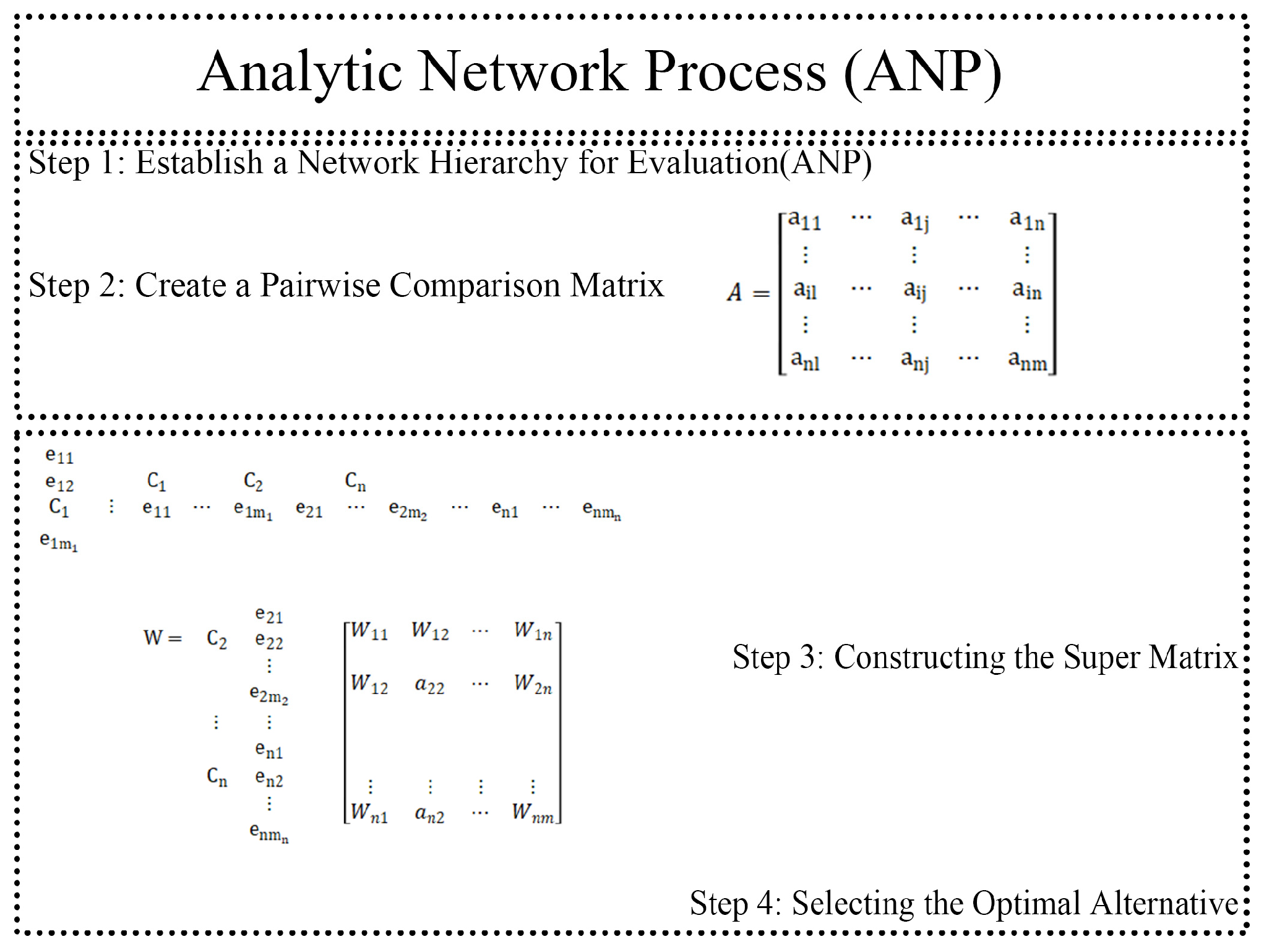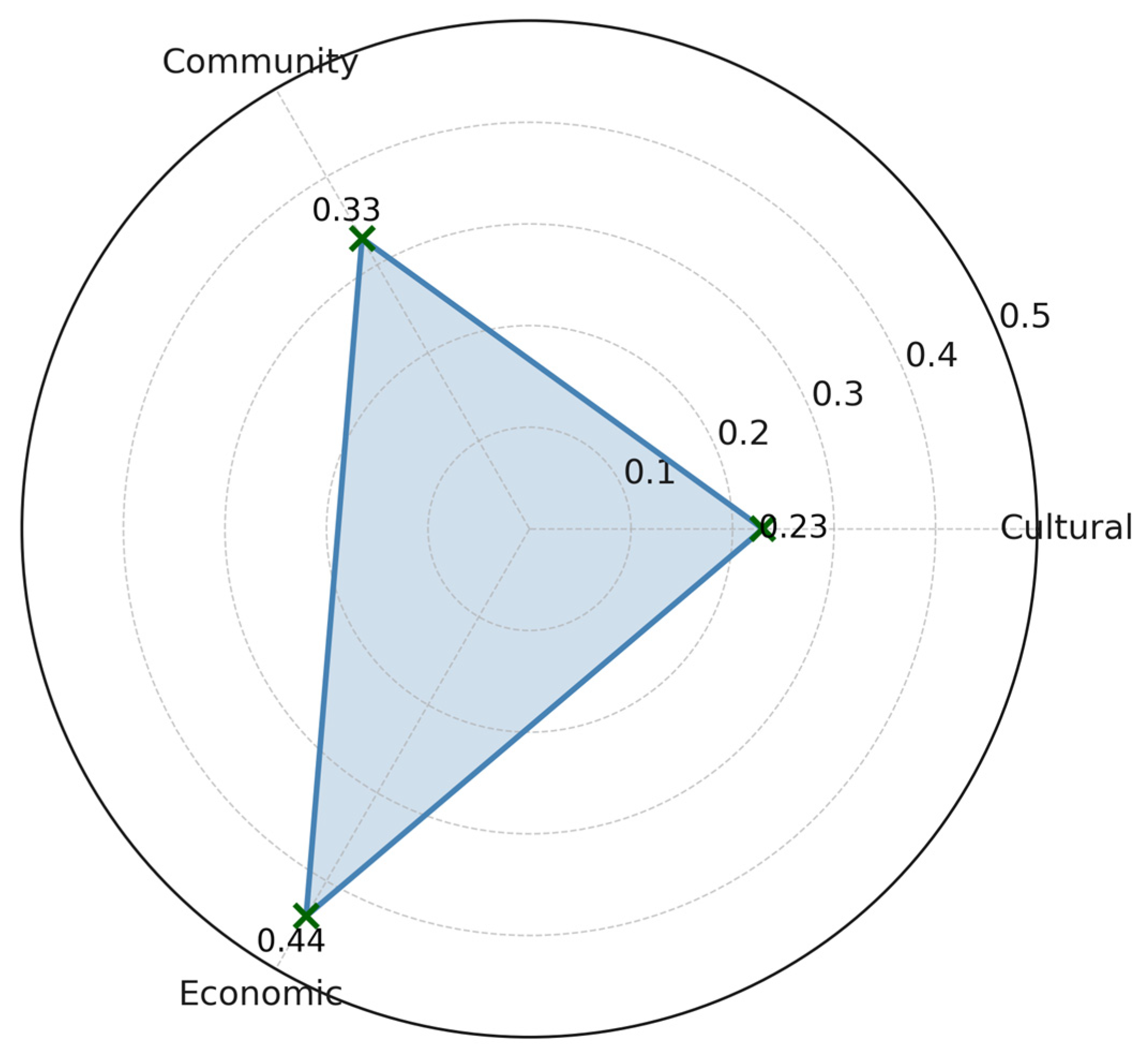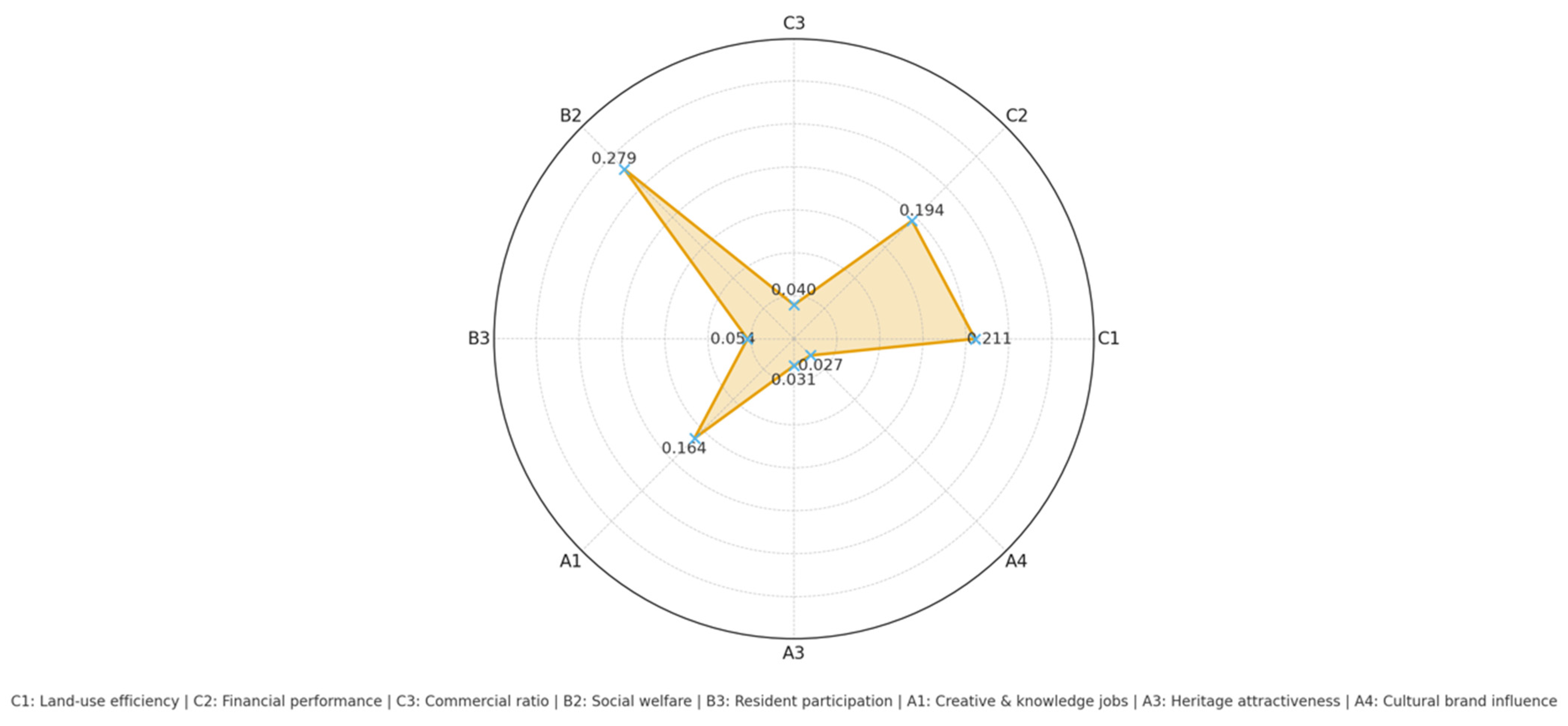1. Introduction
Since the late 20th century, most industrial cities have undergone a phase of large-scale deindustrialization due to globalization, industrial upgrading, environmental constraints, and urban transformation. This represents both a natural stage of economic development and a manifestation of regional repositioning [
1]. Large-scale deindustrialization has led to the abandonment of former industrial zones, creating industrial heritage buildings. These sites and spaces connect the modern world with the works of the past. In different countries and regions, abandoned factories, storage systems and production facilities have been gradually incorporated into the urban heritage system. They are no longer regarded as “symbols of decline” but are re-understood as urban resources with potential for regeneration [
2]. They tell the story of an industry or location’s beginnings, its journey, and its eventual decline over time [
3]. Abandoned industrial heritage sites are not only spatial imprints of past industrial activities, but also endow these industrial cities with distinctive landscapes and unique regional identities [
4]. At the same time, these industrial heritages are generally faced with the dual pressures of protection and redevelopment in actual renewal practices. On the one hand, urban renewal promotes land capitalization and industrial reconfiguration, bringing new economic vitality [
5]; on the other hand, excessive commercial development can weaken the authenticity and community function of heritage sites, triggering social resistance [
6]. Therefore, achieving a balance between economic feasibility and cultural continuity in the process of industrial heritage renewal has become an important prerequisite for evaluating redevelopment strategies [
7].
At present, the sustainable use and renewal of historical buildings has become common around the world. The preservation and reuse of industrial heritage buildings in the renewal of urban industrial land has also been developing [
8]. According to existing research, in the face of development opportunities in urban renewal, revitalizing the stock of industrial heritage resources, while retaining the characteristics and symbolic role of the buildings, while adjusting them to adapt to new functions, has become an important path for the sustainable renewal of industrial heritage [
9]. Although “functional adaptation” is widely regarded as an important path for the sustainable renewal of industrial heritage, this logic exposes a substantial problem: the assumption that functional reuse is equivalent to sustainable development [
10]. As a result, many renewal practices achieve physical reuse while ignoring the balance between economic feasibility, operational logic and social value [
11]. This also results in many projects, while spatially revitalized, failing to establish economic mechanisms that can support long-term maintenance and value conversion, making “revitalization” a fleeting phenomenon rather than a continuous process [
7].
From the perspective of industrial development and economic management, activating the value of industrial heritage is not only about profit returns, but also involves optimizing economic structure, increasing land value and the sustainable operation of community economic systems [
12]. However, existing research focuses on financial returns and investment efficiency, ignoring the continuous impact of community space dimensions on economic feasibility [
13,
14,
15]. For example, in some European industrial heritage renewal projects, the Ancoats regeneration project in Manchester, UK, although the early return on investment was significant, the project experienced community exclusion and social division during the spatial renewal process, which in turn weakened local vitality and social cohesion [
16]. This social acceptance is often rooted in the structure and use patterns of community spaces [
17]. However, the dimension of community space is not simply a physical place, but the intersection of economic activities and social identity [
18]. If there is a lack of public and sharing mechanisms, residents’ recognition and participation will decline, and economic vitality will be weakened [
19]. According to social exchange theory, regional economic performance depends on the fairness of benefit distribution and the sustainability of social interaction. When a project fails to establish a trust and sharing mechanism at the physical space level, even if it has short-term economic benefits, it will be difficult to maintain long-term feasibility [
19]. Therefore, community space is not only a place for social interaction, but also the social foundation for the long-term viability of the economic system [
20].
It is also worth noting that existing research on the economic feasibility of industrial heritage generally adheres to the growth paradigm dominated by investment returns, and only uses culture as a tool for asset appreciation and branding, thereby excluding other values and inducing gentrification and social exclusion [
21]. For example, when New York’s High Line project transformed culture into a real estate brand, it enhanced the region’s image and real estate returns. However, this was accompanied by a housing price premium and community exclusion. Public space gradually shifted to serving high-end consumer groups, resulting in the erosion of publicness, increased spatial exclusivity, and weakening the long-term viability of the economic system [
22]. Although some studies have begun to realize the importance of culture in the heritage renewal economy, they have pointed out that “heritage-led entrepreneurial urbanization” may lead to cultural conservatism and social exclusion [
23]. However, existing research on the relationship between culture and economy is still fragmented, remaining at the level of social equity and governance, and failing to reveal the structural role of culture in economic feasibility through a system model [
24]. Therefore, when assessing the economic viability of industrial heritage, cultural industries should be considered to prevent the capitalization of culture from undermining social inclusion and long-term resilience. In other words, economic viability is not solely determined by investment returns, but is supported by the long-term interaction between cultural locality and social participation. These factors, by shaping local resilience and sustained innovation, constitute the long-term economic foundation of urban renewal.
When the preservation of industrial heritage buildings promotes tourism or other public uses through “museum” formats, it often disrupts the daily activities and community life of surrounding residents [
25]. Against this backdrop, decision-making bodies often place excessive emphasis on the industrial potential and economic value inherent in such heritage sites, failing to balance the conflicting interests among stakeholders. This underscores the practical necessity for a comprehensive and transparent evaluation process. Consequently, decision-making concerning the preservation and reuse of industrial heritage should be approached as a multi-criteria decision-making process [
26].
Previous studies indicate that adaptive reuse aims to provide optimal decision-making and solutions for the transformation of architectural heritage [
27]. Within the context of urban renewal, the rational redevelopment of industrial heritage through adaptive reuse strategies demonstrates the ability to balance historical value with modern functionality. This approach endows such sites with new economic functions and social significance, driving regional economic revitalization and enhancing community vitality [
28]. Additional research indicates that the multifunctional integration achieved through the adaptive reuse of industrial heritage not only promotes regional regeneration but also enhances positive economic factors such as land value and employment opportunities [
29]. However, the redevelopment of industrial heritage buildings faces numerous uncertainties due to restoration costs, structural deterioration, and spatial constraints, making economic viability a key factor limiting their renewal implementation.
Current research on industrial heritage reuse has developed a rich theoretical framework encompassing three dimensions: economic evaluation, social acceptance, and spatial adaptation [
30]. In economic evaluation, traditional research predominantly employs cost–benefit analysis (CBA) models for assessing urban renewal projects, emphasizing financial viability while also acknowledging the difficulty in fully capturing social value [
31]. The rise of multi-attribute decision-making models emphasizes comprehensive evaluation across multiple dimensions, including financial viability, land value, and employment opportunities. Secondly, at the level of social acceptance, based on social exchange theory, balancing project benefits with perceived community acceptance is crucial. Failure to align with community residents’ needs may provoke resistance and distrust among residents [
32]. Additionally, at the spatial adaptation level, within the framework of adaptive reuse, researchers advocate reconstructing the historical functions of heritage buildings under the principle of minimal intervention, enabling them to achieve synergy between modern functionality and spatial efficiency [
30]. Although the theoretical framework is well-established, no structured model has yet been developed to integrate these theories. Furthermore, there is a lack of quantitative tools that can synthesize both subjective and objective factors in terms of weighting and prioritization.
Therefore, the primary research question of this study is: Which analytical model can effectively integrate multiple value dimensions in empirical research to assess the economic viability of industrial heritage buildings? This research question encompasses two key aspects:
First, within the context of urban renewal, how to define the composition of economic value and establish feasibility assessment criteria for the reuse of industrial heritage buildings.
Second, to clarify the prioritization logic among different reuse scenarios (such as commercial conversion, community spaces, or cultural and creative uses) under varying economic orientations, thereby revealing the interactive mechanisms between the economic functional restructuring of industrial heritage buildings and regional development strategies.
In summary, this study aims to select an appropriate multi-attribute decision-making model to evaluate the economic feasibility of reusing industrial heritage buildings in the context of urban renewal, and to reveal the interplay between their reuse and regional development strategies. This model will balance economic requirements with community needs, addressing issues of resource reallocation and heritage regeneration in the transformation of industrial cities. The research objective is to establish an evaluation system that quantifies the economic benefits of industrial heritage reuse, thereby enhancing public acceptance and decision-making rationality. The research design involves: first, compiling literature and identifying key economic indicators through the Fuzzy Delphi Method (FDM); second, using Analytic Network Process (ANP) to calculate indicator weights and prioritize different reuse strategies. This study will use Guangzhou’s iconic industrial heritage site, Guangzhou Steel New City, as a case study to empirically analyze its economic viability and propose strategic recommendations.
3. Research Design and Methods
Multi-Criteria Decision Making (MCDM) provides a systematic and structured decision-making framework for complex scenarios, assisting decision-makers in identifying relatively optimal or satisfactory solutions under multiple objectives and constraints [
52]. Based on this, this paper first employs the Fuzzy Delphi Method (FDM) to determine the selection and definition of key decision criteria from the preliminary indicator set. Subsequently, the Analytic Network Process (ANP) is utilized to characterize the dependencies and feedback relationships among these key decision criteria and calculate their weights. Finally, sensitivity analysis is conducted to examine the stability of the ranking priorities under weight perturbations, thereby identifying the optimal solution with the best overall performance (See
Figure 2).
3.1. Fuzzy Delphi Method (FDM)
In multi-attribute decision-making research, FDM effectively enhances the efficiency of expert interviews and reduces the number of surveys to some extent, enabling more comprehensive expression of expert opinions [
53]. Given potential variations among researchers in defining the economic viability of industrial heritage reuse and its multidimensional indicators, this study employs the Fuzzy Delphi Method (FDM) to select key design factors. This approach ensures evaluation criteria align with Guangzhou Steel New City’s local characteristics while integrating economic, community, and cultural values. The FDM is utilized to screen critical indicators for assessing industrial heritage economic viability based on expert consensus. Following the studies by [
54,
55], the FDM employed in this research utilizes “dual-triangular fuzzy numbers” to integrate expert opinions and employs the “gray zone test” to examine whether these expert opinions exhibit consistent convergence [
53].
The Fuzzy Delphi Method (FDM) is used to screen and revise the initial planning indicator system based on expert opinions to ensure that the evaluation indicators are consistent, representative, and scientific. As shown in
Figure 3, the main steps include:
Step 1: Expert Scoring and Questionnaire Collection. Based on a pre-set semantic scale (e.g., “extremely unimportant” to “extremely important”), multiple domain experts were invited to assess the importance of each indicator, generating preliminary fuzzy evaluation data.
Step 2: Constructing Triangular Fuzzy Numbers. The experts’ semantic evaluation results were converted into corresponding fuzzy triangular numbers (l, m, u) to quantitatively characterize the uncertainty and ambiguity in expert opinions and reflect the discreteness of different expert opinions.
Step 3: Calculating the Composite Fuzzy Value and Conducting a Consistency Check. By calculating the geometric mean of each indicator’s fuzzy value and the expert consensus interval, the average fuzzy threshold Gi for each indicator was obtained, which was used to measure the degree of convergence and consistency of expert opinions.
Step 4: Screening and Determining the Final Indicator. The average fuzzy value of each indicator was compared with the threshold. Indicators exceeding the threshold were retained, while those below the threshold were eliminated. Ultimately, an evaluation indicator system confirmed by expert consensus was formed.
3.2. Analytic Network Process (ANP)
The Analytic Network Process (ANP) is employed to calculate the weights of each indicator after screening, thereby reflecting the interdependencies among indicators. Saaty noted when proposing ANP that real-world decision-making problems often involve feedback and dependencies between levels and among indicators—relationships that the simple Analytic Hierarchy Process (AHP) cannot capture [
56]. Given the complex interdependencies and feedback relationships among indicators such as economic performance, community space, and cultural value in industrial heritage reuse, this study employs the Analytic Network Process (ANP) to depict the network connections between indicators and calculate their weights. This approach avoids the nonlinear coupling effects often overlooked by traditional hierarchical analysis methods, thereby more accurately reflecting the priority ranking of reuse proposals for Guangzhou Steel New City. Consequently, the Analytic Network Process (ANP) is proposed to address such challenges [
56].
As shown in
Figure 4, the ANP method is used to identify the dependencies between multi-dimensional indicators and determine the final comprehensive weights. The process consists of four main steps:
Step 1: Establish a network hierarchy. First, according to the research objectives, group the dimensions and indicators according to the logical relationship, and identify the interdependence and feedback relationship between different elements, so as to form a network hierarchy evaluation model.
Step 2: Create a pairwise comparison matrix. Based on the 1–9 scale proposed by Saaty, invite experts to compare the dimensions and indicators pairwise to form a judgment matrix. Then calculate the eigenvectors and eigenvalues and perform a consistency test (CR < 0.1) to ensure the reliability of the judgment.
Step 3: Construct a supermatrix. Aggregate the local weight results into an unweighted supermatrix, and then weight it according to the weight of the dimension layer to obtain a weighted supermatrix. Through power operations, the matrix converges to a limit supermatrix, reflecting the long-term balance influence of each indicator in the system.
Step 4: Select the optimal solution. Extract the final weight value from the extreme supermatrix and perform a comprehensive ranking based on the evaluation results of each solution to determine the reuse solution with the highest priority.
3.3. Grey Relational Analysis (GRA)
Grey System Theory, proposed by Deng Julong, is used to uncover systemic patterns under conditions of uncertainty and incomplete information [
57]. Grey Relational Analysis (GRA) is one of the commonly used methods in grey system theory, employed to quantitatively measure the closeness of relationships among various factors (or sequences) within a system [
58]. This method determines the degree of closeness in relationships by leveraging similarities and differences between comparison sequences and reference sequences. It can rank the influence of various factors on a system even under conditions of incomplete data and small sample sizes [
58]. In other words, GRA can identify the set of factors that most significantly impact the research objective based on limited observational data, thereby providing a basis for decision-making.
First, define the reference sequence and the set of comparison sequences. Let the reference sequence
represent the ideal standard or system characteristic benchmark for the research subject; There are k comparison sequences
), where each sequence represents the observed values of an alternative option across
n indicators. To eliminate dimensional differences and highlight trends in sequence variations, data typically undergoes dimensionless preprocessing, such as “initialization”—setting the first value of each sequence to zero. The calculation formula is:
By setting the initial value of the sequence to zero, random fluctuations can be smoothed out, highlighting the evolving trends in system behavior. After completing the preprocessing, calculate the absolute difference between the reference sequence and the i-th comparison sequence for the j-th metric
Record the minimum and maximum differences across the entire dataset:
and
. Based on this, the Grey Relational Coefficient can be calculated to measure the similarity of sequences across each indicator. The commonly used relational coefficient formula is:
where
∈(0,1] is the discrimination coefficient, typically set to
= 0.5. The above formula yields a correlation coefficient matrix with values between 0 and 1. The grey correlation coefficient
possesses the following properties: (1) Its value range is 0 < ξ ≤ 1; (2) It depends solely on the similarity of trends between the reference sequence and the comparison sequence, while being largely unaffected by numerical magnitude and dimensionality (due to the dimensionless processing); (3) Values closer to 1 indicate greater similarity between the two sequences.
Next, the Grey Relational Grade is calculated to comprehensively evaluate the closeness of association between each comparison sequence and the reference sequence. Traditional GRA assumes equal weights, where the arithmetic mean of the correlation coefficients among all indicators serves as the relational grade. For example, for
n indicators, the relational grade of sequence
relative to
can be expressed as
, where the value ranges between 0 and 1. A higher value indicates greater similarity between sequence
and
However, in multi-criteria evaluation, the importance of each indicator to the decision objective is often unequal, necessitating the assignment of different weights for differentiation. To this end, multi-criteria decision-making methods such as the Analytic Network Process (ANP) can be employed to determine the relative weights of each indicator. ANP is an extension of Saaty’s Analytic Hierarchy Process (AHP), allowing for dependencies and feedback relationships between indicators. It calculates stable weight vectors through iterative supermatrix computations. In practice, experts first conduct pairwise comparisons and scoring for each indicator, constructing a judgment matrix and calculating the eigenvector. After normalization, the global weights
for each indicator (with the sum of weights equaling 1) are obtained to reflect their relative importance. Subsequently, this weight vector is incorporated into the calculation of grey correlation degrees. The weighted formula for grey correlation degrees is:
represents the grey correlation degree of the i-th comparison sequence relative to the reference sequence, while denotes the global weight of the j-th indicator obtained through expert judgment and the ANP method (satisfying ). Gray relational analysis weighted by ANP weights more fully reflects the varying degrees of influence each indicator exerts on the system. This approach yields a calculated ranking of relational degrees that better aligns with practical decision-making needs, thereby enhancing the scientific rigor and credibility of the evaluation results.
3.4. Empirical Case Description
This section details the selection of empirical cases, data collection, and analysis processes. Based on the evaluation results, it focuses on discussing key improvement areas and comprehensive analysis.
This study selects Guangzhou’s Guanggang New City as its empirical case. The planned land area of Guanggang New City totals approximately 6.57 square kilometers, with a total planned floor area of about 10.24 million square meters. The planned residential population is approximately 207,000, resulting in a population density of 31,500 people per square kilometer. As a large-scale industrial heritage redevelopment project within the old city district, Guanggang New City initiated its urban renewal following the complete shutdown of the Guangzhou Iron and Steel Plant in 2013. The goal is to transform it into a “distinctive livable new district” integrating residential, commercial, and cultural functions. The master plan emphasizes functional transformation while preserving industrial heritage, featuring a large central park connecting industrial relics and creating an ecological residential zone—a rarity in Guangzhou’s historic districts. After over a decade of development, Guanggang New City has taken shape with towering residential buildings and progressively improved municipal facilities, emerging as a representative case of urban industrial heritage renewal in the Pearl River Delta region.
The selection of Guangzhou Steel New City as a case study is primarily based on the following factors. First, the scale of the site’s renewal is substantial, and its location is unique. Situated in the central urban area of Guangzhou, the Guangzhou Steel New City project involves the comprehensive redevelopment of 657 hectares of land. As a large-scale industrial land redevelopment project, it exhibits strong representativeness. Second, Guanggang New City prioritizes the preservation and revitalization of industrial heritage. While balancing commercial and financial returns, it incorporates 14 industrial relics—including blast furnaces and railway locomotives—into the central park system for conservation. This creates the Greater Bay Area’s first systematic industrial heritage exposition park, highlighting cultural memory and heritage value. Third, the project’s functional layout embodies multiple objectives—economic, community, and cultural. Distinct functional zones (such as the Central Industrial Heritage Exhibition Park, the Southern Residential Complex, the Northern Commercial and Business District, and the Railway Town Cultural Tourism Corridor) each have distinct focuses. This not only provides an objective basis for multi-option comparison but also aligns closely with the multi-attribute decision-making methodology (ANP–GRA) employed in this study (See
Figure 5).
Finally, the development and implementation of Guangzhou Steel New City fully embodies a governance model that combines “government guidance with market participation.” The Guangzhou Municipal Government has taken the lead in heritage preservation and infrastructure provision through control detailed planning, policy support, and public space development (See
Figure 6). Meanwhile, social capital plays a dominant role in residential and commercial development, accelerating the district’s renewal process. This collaborative model not only safeguards public interests but also enhances investment efficiency, providing a replicable practical model for industrial heritage renewal research.
3.5. Selection of Questionnaire Survey Experts
During the questionnaire distribution process, this study defined the expert group as individuals possessing relevant knowledge of the research questions, capable of understanding and accepting this questionnaire format, and maintaining active cooperation throughout the survey period. Research indicates that expert panels comprising between 10 and 30 members exhibit the fewest attribution errors and the highest reliability [
56]. To maintain objectivity and following the methodology of Yao et al. (2022) [
56], this study employed expert judgment sampling to distribute 15 expert questionnaires, all of which were valid. To better assess the economic feasibility of adaptive reuse for industrial heritage, we utilized the aforementioned FDM to interview 15 experts, including accountants and appraisers in the economic field, urban planners, and masters in cultural heritage studies. The experts in this study possess extensive experience within their respective professional disciplines. Furthermore, most have participated in urban or project evaluation initiatives. The table below lists the expert information for this study (See
Table 1). Their deep understanding of the subject significantly contributed to this research. Furthermore, as accountants currently predominate (7 out of 15), future iterations should broaden participation to include community representatives and heritage NGOs to ensure inclusiveness. Since the research focuses on adaptive reuse, experts were asked to appropriately consider both internal and external factors influencing operational decisions for such heritage sites. Researchers maintained communication with experts throughout the interview phase to minimize potential misunderstandings or personal biases. Ultimately, eight key criteria were selected for inclusion in the decision-making model.
5. Discussion
Industrial heritage, influenced by both functional obsolescence and historical baggage, faces a negotiation between “material renewal and narrative continuity” in its reuse. The dark legacy inherited from buildings originally constructed for specific services or production complicates adaptive reuse, requiring a consensus between the new identity’s function and the site’s narrative [
54]. Therefore, this study employs the FDM–ANP–GRA model to propose specific functional decision criteria for the economic feasibility of adaptive reuse in industrial heritage. For example: C1 (enhancing land use efficiency), C2 (investment financial performance), and C3 (commercial function ratio). To ensure adaptive reuse achieves implementable and sustainable operations, it is necessary to measure the spatial efficiency of new functions, verify economic and financial viability, and calibrate the intensity of business formats [
59]. This will better serve surrounding communities, enhance public recognition and usage rates. This dependency is particularly pronounced in commercial districts, where newly introduced adaptive functions typically require support from more developed surrounding infrastructure [
60].
Industrial heritage buildings possess cultural relevance, requiring additional consideration of their cultural attributes and their integration into the city’s inherent cultural fabric. They should be incorporated into the contemporary urban landscape through a unified approach that emphasizes their cultural significance [
54]. Furthermore, within the cultural dimension of this study, enhanced heritage participation and appeal strengthen the preservation and interpretation of adaptive reuse heritage value, as the introduction of new functions often further contributes to the neglect of such historic buildings [
61]. Against this backdrop, Guangzhou Steel New Town was selected as the case study for this research’s economic feasibility assessment for two reasons. First, it stands as a representative project of large-scale industrial heritage renewal in Guangzhou, having completed a phased transformation from a steel plant site into an industrial heritage park/urban park with mixed-use zones. It preserves multiple industrial relics while introducing public and operational functions. Second, the Guangzhou Steel project is discussed as a key case of culture-driven regeneration in Guangzhou, addressing how industrial heritage can be integrated into the processes of city branding and spatial production. Placing it within a quantitative framework of economic feasibility helps bridge the gap between previous narrative/political–cultural discussions and quantifiable assessments of operational investment, enhancing the comparability and transferability of the research [
62].
Existing research indicates that adaptive reuse involves a structural tension between cultural preservation and economic development [
63]. Based on the grey correlation results, it can be observed that the culturally oriented reuse schemes for Central Park (Scheme A) and Railway Town (Scheme D) exhibit certain disadvantages in economic and community dimensions. The increased weighting of cultural orientation reduces their suitability for commercial uses. Conversely, the commercially oriented Business District (Option C) demonstrates a significant lead in economic alignment. This aligns with theoretical expectations regarding the “culture-economy” tension, indicating a ranking order based on differing value trade-offs rather than a rejection of cultural value.
Furthermore, this “economic-cultural” tension is not only reflected in the case of Guanggang New Town, but also reveals the general contradictions in current urban renewal policies. On the one hand, economic rationality often becomes a prerequisite for project implementation and funding decisions, reinforcing the profit-oriented “economic determinism”; on the other hand, cultural sustainability requires the continuation of local characteristics, historical continuity and social identity, and emphasizes non-quantifiable long-term value. This contradiction forces urban renewal to confront the challenges of value trade-offs and rebalancing at different stages of development. This study’s multi-attribute evaluation framework is portable across regions and can achieve a dynamic balance between economic, community, and cultural dimensions across different types of post-industrial cities. By localizing the weights of indicators, the model can help cities around the world maintain a sustainable development path of cultural heritage and social inclusion while pursuing economic returns.
6. Conclusions
This study verifies the feasibility of industrial heritage reuse in balancing economic performance, community space and cultural value, and provides a quantitative basis for sustainable urban renewal. Based on the empirical context of Guangzhou Guanggang New Town, this study proposes an actionable multi-attribute decision-making framework to comprehensively quantify and rank economic, community, and cultural indicators. The results show that economic performance has the most significant impact, while community and cultural factors play a key supporting role in long-term sustainability. Local governments can use this to identify optimal reuse options, set investment priorities, and quantify cultural and social impacts. Compared with previous conceptual or static evaluation models, this study points out three shortcomings: first, the lack of operability makes it difficult to directly guide urban renewal practices; second, the lack of quantitative mechanisms makes it difficult to make objective comparisons across multiple dimensions; and third, the lack of adaptability to regional contexts ignores the impact of local economic structures and cultural differences. To address these issues, this study integrates expert knowledge and data through the “fuzzy Delphi-ANP-grey correlation” integrated framework, which not only improves the model’s feasibility and quantitative accuracy but also enhances its adaptability in different urban contexts. For municipal planning departments, this model can serve as a supporting decision-making tool for project approval, funding allocation, and functional adjustments. By regularly updating indicator weights, it can dynamically reflect changes in urban development stages and policy orientations. Overall, this research theoretically strengthens the structural connection between the economic viability and cultural sustainability of industrial heritage and, in practice, provides a replicable and transferable quantitative assessment approach.
6.1. Contributions
This paper contributes by proposing a decision-making model for the economic viability of adaptive reuse in industrial heritage. Integrating an urban sustainability perspective and grounded in adaptive reuse decision criteria, it translates the concept of “multi-objective negotiation”—emphasizing economic feasibility, social embeddedness, and cultural sustainability through functional transformation within existing spaces—into a measurable three-dimensional evaluation framework [
15]. Using Guangzhou Steel New Town as a case study to validate the model’s applicability for heritage preservation and sustainable urban development.
Nocca et al. proposed a multi-criteria evaluation framework for the adaptive reuse of industrial heritage centered on intrinsic value [
14]. Compared to value-oriented assessments focused solely on intrinsic value, this study adopts a more empirical approach, translating concepts into quantifiable and comparable metrics. Consequently, it not only fills the gap in typological decision-making standards but also provides a new quantitative perspective and operational tool for assessing the role of architectural heritage in achieving sustainable development goals.
6.2. Limitations
This model still has limitations. First, it exhibits significant scenario dependency, as it operates under the premise that “the target architectural heritage has been designated for adaptive reuse.” Given the model’s deep coupling with local urban characteristics, its external generalizability is limited; when applied to different urban contexts, decision criteria should be re-evaluated and alternative functional sets reconfigured. Second, this study only examines the relative merits of multiple options under static conditions, without delving into how external environmental changes during long-term operation—such as market demand fluctuations or policy adjustments—affect the feasibility of proposed solutions.


